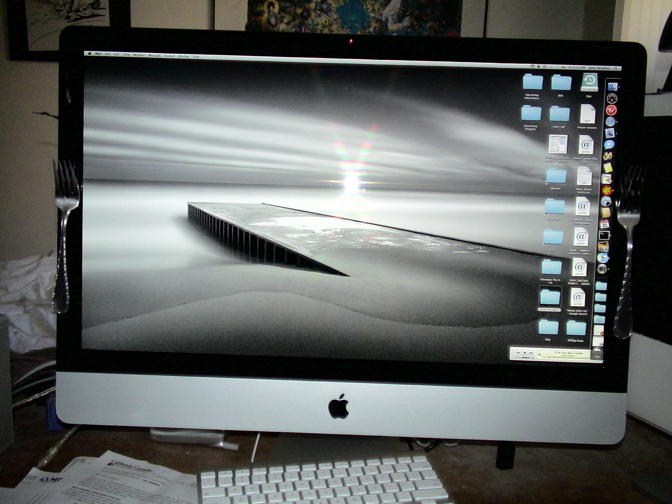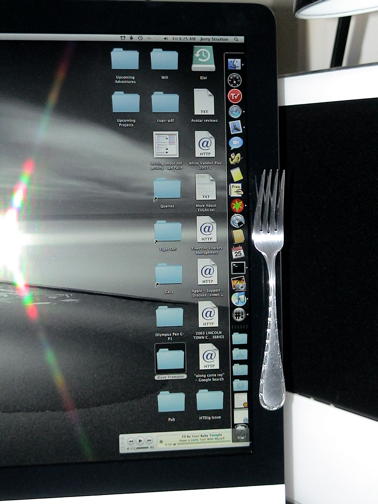iMac Core i7 (with forks)

My new iMac arrived on Tuesday. It has a real magnetic personality! The glass covers of the new iMacs are held on by strong magnets on the sides and top. That ought to be useful for something, but nowadays few things are the right kind of metal. No line of quarters like an old arcade: none of the coins I tried to line the sides with stuck. Even my forks and spoons wouldn’t stick. I had to dig deep in the silverware drawer to find some old forks that still had enough metal of the type attracted to magnets.
It is monstrously impressive at first sight. The 27-inch screen means it’s in a very large box. It was surprisingly light; when I picked it up I could have sworn it didn’t weigh any more than the 20-inch iMac I bought over four years ago. (In fact, it weighs only 5.3 pounds more, according to Apple’s technical specifications.)
And it’s fast. The main reason I got it was to improve the speed of my custom Django CMS. A rough test of rendering a particularly complex page for upload: 25 seconds on the iMac G5 2GHz vs. 5 seconds on the iMac Core i7 2.8GHz1. Publishing is a lot faster now.
So far, knock on wood, etc., it’s been a nice Christmas present to myself.
I did, of course, run into some issues, and I’m wondering about replacing a handful of very useful PowerPC-only applications.
Migration Assistant takes forever
Migration Assistant kind of sucks. I set it up to import my data, and at first it said 10 hours. And it kept rising, until, after about an hour, it was going to take another 28 hours to finish. I finally cancelled and copied everything by hand—it only took two hours, and I had better control.
Migration Assistant also appears to be fragile. Quitting seems to necessitate a restart of the computer.
Reusing Time Machine backups
Time Machine has become more than just a backup program. It’s an integral part of how I work, a fourth dimension in file management. I use it to compare changes all the time, and just the knowledge that it’s there and a click away is extremely helpful. So I very much did not want to start over with the new computer. I wanted to use the old computer’s Time Machine backup as a starting point for the new one’s. A quick search indicated that Snow Leopard handles this automatically, but for me, it didn’t. Even if I renamed the computer to be the same as the old one, Snow Leopard wouldn’t ask if I wanted to re-use it.
I noticed that most people who it worked for used Migration Assistant. I, of course, wasn’t willing to wait that long, and didn’t. So I went into Migration Assistant to see if I could find a relatively non-destructive use; I imported the computer’s settings and nothing else. The assistant still failed—it had an error when it imported the Network settings, and then the progress bar stayed at the same place for about half an hour. I had to quit (and restart, as the computer was very, very slow after quitting).
But when my computer came back up, I finally got the “Reuse” dialog. So presumably there’s something in the computer settings import that marks the Time Machine backup for re-use. I suspect the “Machine” settings, but I don’t know for sure.

Man, Steve Jobs wants you to store everything on the dock!
I also had to restore Apache’s configuration file. Migration Assistant had copied in the one from the old computer (via the backup) and this Leopard config didn’t work with Snow Leopard. Of course, that may have been because Migration Assistant didn’t quit normally.
PowerPC-only applications
This is my first Intel-based Macintosh. There were three applications I was worried about most. I’ve already switched to Nisus for word processing, but three applications I rely on daily are Notes, MathPad, and SilverService, all of which were, last I checked, abandoned. But it turns out SilverService might be back in semi-development. I had to download the new source and compile it myself, but it compiled easily and I now have a Universal SilverService. Rob Hague’s plan to release a new version with no new features and just bug fixes is fine with me—SilverService is pretty close to exactly what I want in a Services script repository.
Notes and MathPad are more difficult to find a replacement for. Richard Schreyer’s Notes (latest version I know of is 1.3.4) is just about the perfect note-taking app, made all the more perfect by its use of an XML file to store the hierarchy and a series of RTFd documents for each note. But it was abandoned years ago; I can’t even find a download for it online any more. The closest to Notes I could find was MacNote3, but while it is Universal, it doesn’t appear to use an easily-parsed format. While Notes’s open format will make it easy to convert to a new app, I want that new app to also be easy to convert from. It looks like if I switch to MacNotes I’m stuck in it. That said, it looks pretty nice, and except for an open format it has everything I want: hierarchical notes quickly entered and easily searched; and possibly even iPhone synchronization2.
I also can’t find any MathPad-like application. What makes MathPad useful to me is the freeform ability to type in calculations, and change previous calculations to recalculate; it’s almost like a freeform spreadsheet without columns or rows.
And on the website side of things, DNSTran is invaluable when using Analog to analyze web server logs. It can go through tens of thousands of IP addresses in a few seconds, where analog will take half an hour or more.
Rosetta works fine for now, but I’m sure it will eventually be discontinued. So this is sort of a bleg. Anyone know of any really good hierarchical notepads (preferably ones that use a simple, open file format), mathpads, and (for those who use Analog) dns caching utilities?
- April 20, 2011: Intel-native DNSTran now available for Mac OS X
-
DNSTran is now up to 1.5.4, and as of that version is Intel-native. That brings the Rosetta apps I want to run down to two. While at this point it looks like Richard Schreyer’s Notes and Mark Widholm’s MathPad will never be updated, they’re not as old as the previous version of DNSTran was, so who knows?
And yes, I’m still using Analog for web log analysis, which is why I need a tool like DNSTran. Thanks, Jason.
I’m using SQLite as the backend database; and mod_python on the old iMac vs. mod_wsgi on the new one. And of course the old iMac, being a PPC, is Leopard with 2 GB RAM and the new iMac is Snow Leopard with 4 GB.
↑Albeit in a fairly hacky manner: it can synchronize one hierarchy by saving it in and reading it from the Addressbook. I suspect this is more Apple’s fault than MacNote’s, though.
↑
- Analog: WWW logfile analysis: Stephen Turner
- Probably the most widely used web server ‘hits’ analyzer. It is available for most platforms. It is extremely fast, and if you’re a programmer you can do wonders with the computer-readable output.
- DNSTran: Jason Linhart
- The OS X command line version still runs under Intel macs, as long as you have Rosetta installed. It’s a lot faster than relying on Analog to do DNS lookups.
- MacNote3: Nobuatsu Sekine at Spread Your Wings
- “MacNote3 retains all of the features of MacNote, while offering a wide range of more sophisticated features in addition. These include facilities for the selection of multiple pages and the exportation of images. It still has the familiar interface, and very quickly responds to commands. MacNote3 is similar to Notepad, or Scrapbook, and so is easy to use. Also, via AppleScript—or by means of regular expressions—it allows the user to edit text.”
- SilverService and Snow Leopard: Rob Hague at Rob Hague’s Blog
- “I’ve dusted off the (now pretty ancient) source code, and got it compiling under the latest XCode. It basically works, but has at least one major interface bug, and one more minor problem that has been present since the start. I plan to look into these over the next few weeks, with the aim of producing an updated version with bug fixes but no new features.”
- Snow Leopard’s New Time Machine Behavior After Logic Board Replacement: Gerrior at blog.gerrior.com
- “I was pleasantly surprised to discover Snow Leopard knows about this problem and has a solution. My first backup with the new logic board resulted in the following dialog: ‘Would you like to reuse the backup /Volumes/Data/Nemo.sparsebundle with this computer? The backup was created on a different computer. If you reuse this backup it can no longer be used by the original computer.’” (Hat tip to How to recycle/reuse/continue Time Machine for a new Mac?)

Oh, and Merry Christmas!